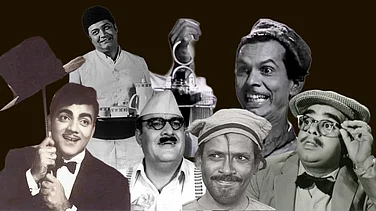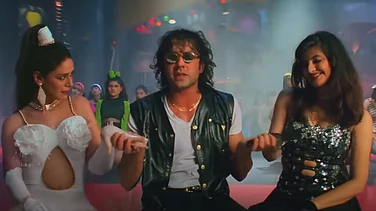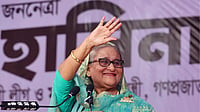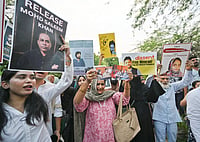The play, inspired by Somadeva Suri’s Yashastilaka written in 950 AD, centres on the Jain abhorrence of violence in any form—particularly of value-less blood sacrifices. No sharper parallel seems likely at this juncture with the Indo-Pakistan conflict. As in the ancient tale, Karnad’s play deals with the story of a king, his queen and the queen mother, but now also joined by a lowly mahout.
The play opens with the mahout and the queen in a temple courtyard after a sexual interlude. The mahout, who has a lovely singing voice, has roused the queen from her lord’s side and drawn her to the temple. They are surprised by the king who has followed his wife out of the palace and has heard the sighs and groans of love, not once but twice.But the king does not, in the style of all epics, instantly run his wife through with a sword. For one thing, he has been converted to Jainism by her and, more importantly, he is not carrying a sword. He also happens to care deeply for her. She has so far not borne him a child and has already had a miscarriage.
The king had even dreamed his wife’s infidelity. While he does not want to act, his mother has no such qualms. To cleanse the family name and assure the honourable continuance of the royal line, the queen mother decides that a hundred fowl shall be sacrificed. This suddenly becomes the focus of an intra-family conflict. In the end, it is the queen who kills herself. She, by herself, is the only true sacrifice in expiation of her sin. Her act becomes the expression of the anger and violence in each one of us.
Bali is the outcome of a brief given to Girish Karnad by Vayu Naidu, the play’s commissioning producer. It required Karnad to consider the global impact of India’s partition on a millennial civilisation. Karnad, in turn, chose to look at the anatomy of violence and non-violence as expressed by the themes of the Jain epic.
The Leicester Haymarket Theatre gave the play production values and theatrical effects which afford it the unmistakable look of little expense having been spared. Perhaps the most remarkable aspect is its conception as a near musical. The lyrics by Karnad have been set to music by Andrew Dodge. And it isn’t the "fusion" cliche we have learned to accept. Dodge evokes rather than states. One musical solution that was imaginative as well as highly effective was the use of a jazz saxophone to represent the mahout’s voice.
Bali was also blessed to have two fine actors, Neve Taylor as the queen and Gary Turner as the king, both of whom have excellent singing voices and the talent to get under the skin of demanding roles. The play has been directed with sensitivity and flair by Nona Shepphard. But there is no doubt that, despite a lack of lines and time onstage, the success of the production is Naseeruddin Shah’s singing mahout. The writing of the play is contemporary and conversational, not in the "epic" style. This suits the actor’s inimitable informality and droll gifts. There is little doubt Naseer will be the star attraction in a city with one of the largest ethnic Indian populations in the UK. Ratna Pathak Shah as the queen mother is a steely, dominant force with a benevolent Lady Macbeth-like quality.
The play’s basic conflict is less human than one of philosophies. It is not easy to engage audience emotions nowadays in the cut and thrust of ideas and intellectual stances. That the production succeeds is as much a tribute to the play itself as to the remarkable cast. To the physicality of sound and sight must be added the production’s use of the power of myth. In Bali, pseudo-historical figures have been given the enormous stature of myth. It’s one of the prime ingredients of the production’s appeal and the force of its ideas.


























